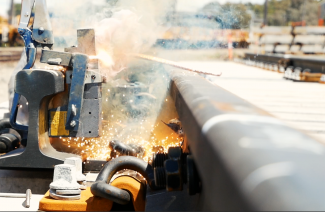This nationally recognised engineering program enables participants to gain a valuable rail track qualification.
Originally published on Engineers Australia's create.
The new Diploma of Engineering Infrastructure (Rail) is transforming the rail industry by providing an accessible, holistic qualification for engineers and technicians. It is the culmination of close collaboration between industry, academia and the profession through Engineering Education Australia.
When Transport for New South Wales (TfNSW) analysed the state of rail track engineering in Australia, the industry-based team identified significant skills gaps.
One key deficiency was that trade-qualified staff lacked a broad view of the issues and interfaces in rail track engineering. Another issue was that early-career engineering professionals needed foundational skills in rail track engineering and management.
And non-engineering professionals too needed to be able to rapidly acquire skills in the fundamentals of rail track engineering.
As the Manager of Track Programs at Sydney Trains at the time, Anna Murray (now Track Renewals Manager at Metro Trains Melbourne) was part of TfNSW’s early efforts to develop a Diploma of Engineering Infrastructure (Rail).
“We heard about the same issues from rail industry interest events and management feedback,” she said.
“It was clear that there was a need for training across the board.”
Using this input, TfNSW approached Engineering Education Australia (EEA) to develop a suitable course. The University of Tasmania was engaged to standardise and deliver it, a collaborative approach that resulted in a nationally relevant qualification.
Making training accessible
From the start, it was clear that any course had to be open to practitioners from many backgrounds. That’s why the course is set at an undergraduate diploma level.
Accessibility opens up the diploma beyond engineers and technicians to professionals as well. It also provides veteran rail staff who don’t yet have formal recognition for their skills with access to qualifications. Anyone wanting to reinforce foundations in rail track engineering or specialise in the rail industry can study.
“We wanted the course to allow people to appreciate the value of their experience, round off skills and provide recognition,” Murray said.
The diploma also needed to provide excellent technical foundations in rail track engineering, which isn’t covered in undergraduate or trade qualifications. With the help of industry and subject matter experts, the team embedded rail track training in real-life case studies.
The diploma is offered fully online through a blended delivery format, making it readily accessible. Participants come from diverse career backgrounds, which means their perspective offers unique insights into a variety of cross-rail issues. This process creates networks across departments, divisions and disciplines.
Strengthening the rail industry
Even though there are different rail standards across Australia, the diploma is a national qualification that can be applied to the public and private sectors as well as all types of rail — passenger, heavy industry and light rail.
The course draws on industry experts as facilitators and aims to broaden perspectives of the participants on rail track issues.
Murray explained, “The course makes participants realise that rail engineering is an interdependent industry. One part just doesn’t work without the others”.
She added that rail’s future development depends on investing in engineers, technicians and professionals for a resilient and productive workforce.
“Only with that workforce can we push the boundaries of innovation and efficiency,” she said.
The Diploma of Engineering Infrastructure (Rail) is offered by the University of Tasmania and backed by Engineering Education Australia. The Diploma is suitable for current rail engineers and technicians.
Enrolments are now open for 2022, find out more about eligibility and requirements.
